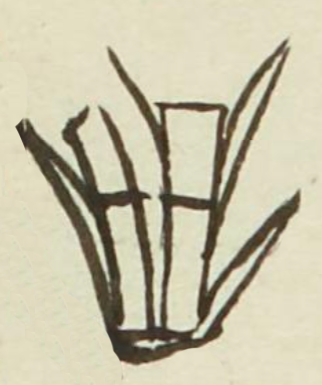Omaca (MH593v)
This black-line drawing of the simplex glyph for the personal name Omaca (short for Ome Acatl, “Two Reed,” attested here as a man’s name). The name involves a day sign (acatl) and an implied numerical factor (notation) of two (ome). What we see is a frontal view of two reeds or canes connected at the bottom. Four tall, slender leaves come up from the same base and from behind the canes.
Stephanie Wood
The two components of the calendrical name have become fused, abbreviating the number and dropping the absolutive of the day name. By the time of this manuscript (1560), calendrical names were in a process of evolution, away from the old system, perhaps impacted by the colonial setting where old 260-day divinatory religious calendar, called the tonalpohualli, was being discouraged. Chicomaca, which would have originally been Chicome Acatl, also fits this pattern. One example appears below, along with two others that have not gone so far as to drop the absolutive from the Acatl.
Stephanie Wood
bartasal omaca
Baltazar Omaca
Stephanie Wood
1560
Jeff Haskett-Wood
dates, fechas, two, dos, reed, caña, números, días, days, calendars, calendarios

ome, two, https://nahuatl.wired-humanities.org/content/ome
aca(tl), reed, https://nahuatl.wired-humanities.org/content/acatl
Dos Caña, o 2-Caña
Stephanie Wood
Matrícula de Huexotzinco, folio 593v, https://www.loc.gov/resource/gdcwdl.wdl_15282/?sp=266&st=image
This manuscript is hosted by the Library of Congress and the World Digital Library; used here with the Creative Commons, “Attribution-NonCommercial-ShareAlike 3.0 License” (CC-BY-NC-SAq 3.0).




